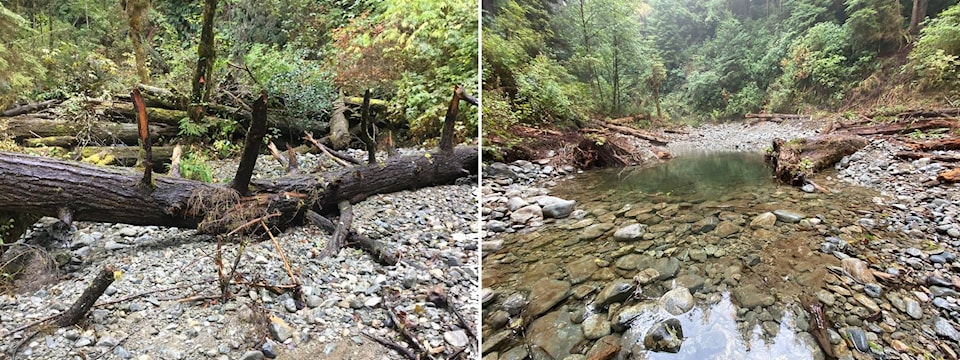A Vancouver Island First Nation is celebrating the restoration of three salmon-bearing streams after decades of habitatdecline and destructive forest practices.
This summer workers from the Ditidaht First Nation joined with Parks Canada to clear more than 3,000 cubic metres of debris from the Cheewaht Lake watershed, part of the Pacific Rim National Park Reserve, restoring one kilometre of cohoand sockeye habitat. Completion of the project gives the fish access to an additional 100 metres of spawning ground that’sbeen inaccessible for two decades.
Brian Tate, elected chief of the Ditidaht First Nation, said aside from a few elders who look forward to again harvest small amounts of salmon from the streams, the nation will largely allow the streams time to recover.
READ MORE: Permanent fishway approved for Big Bar landslide site
In the 1970s environmental concerns prompted the federal government to extend the park boundaries around the watershed, to serve as part of the West Coast Trail Unit, giving all spawning areas federal protection under the Canada National Park Act.
Meanwhile, legal logging along the park’s boundary caused stream blockages and flooding of forested areas in the watershed, leading to both lost salmon habitat and the death of old growth trees — the area is home to the largest in Canada, a western red cedar known as the “Cheewaht Giant”.
Through the 1990s, as studies tracked the steady decline of salmon in once-flourishing creeks, the Ditidaht community brought attention to the matter as a food-security issue, collaborating with private, public and non-profit sectors to find solutions.
A working group began developing an action plan in 2009, and this year Parks Canada kicked in with personnel and $1.1 million in funding through the Conservation and Restoration Program for the all-important last step of stream restoration.
Through the summer and fall, temporary corduroy roads were laid down for small machinery to transport equipment to the edge of Cheewaht Lake, where it was then barged to work sites.
Stream beds were reestablished along historic routs using natural materials to stabilize the banks, and the stream-bed elevation was lowered to pre-logging conditions. The tops of the stream banks were also re-vegetated with native plants to stabilize the areas during storms.
READ MORE: Discovery Islands salmon farms on their way out
In October, adult sockeye and coho began returning to the watershed, spawning successfully in all three of the streams. As many as 1,300 adult fish were spotted in one day.
“The Cheewaht Lake Watershed has been a very important system to the Ditidaht people, as they gathered their salmon needs – more importantly Sockeye – as this was a favorite salmon. Families owned rights to certain spots on the Cheewaht River and built fish weirs to harvest their Sockeye needs,” Tate said. “Young men would camp out on the Cheewaht River during the Sockeye run and harvest for families at Wyah, Clo-oose, and Cheewaht villages. These salmon harvest practices built family bonding and unity through helping and sharing with each other.”
In a background statement on the project, the federal government acknowledged the Ditidaht nation was not adequately engaged on the establishment of the national park reserve, and were unfairly restricted from their traditional territory decades ago. It aimed to correct that in the recovery of the Cheewaht salmon streams by forging a partnership that recognized the value of Indigenous knowledge in land management decisions.
“Wild Pacific salmon are vital to the culture and livelihoods of many on the West Coast, particularly Indigenous peoples,”Jonathan Wilkinson, minister of environment and climate change said. “This important partnership between Parks Canada and Ditidaht First Nation supports on-the-ground conservation work that will help local sockeye salmon populations recover, and in turn, support the health of the Ditidaht community and surrounding ecosystem for generations to come.”



